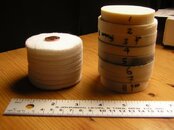Scuba Compressor or SCBA Air Fiter Canister 5000 PSI Uses Std Filters | eBay
This is what we use. We use pad retainers, synthetic felts pads, and then hand pack them.
They hold about a quart or so of media.
I'd probably do:
50% MS13X
10% Hop
40% AC
You want to plumb from the bottom up. The 15 micron filter at the end is good in case some of the media weasels past the felt pads.
I suggest mixing some drierite crystals in with the MS13X. It'll give you a good idea of your service interval for your filter.
Ah nice, now were talking a bit more reasonable pricing. Those $800 stacks minus any filter cartridge are flat ridiculous.





